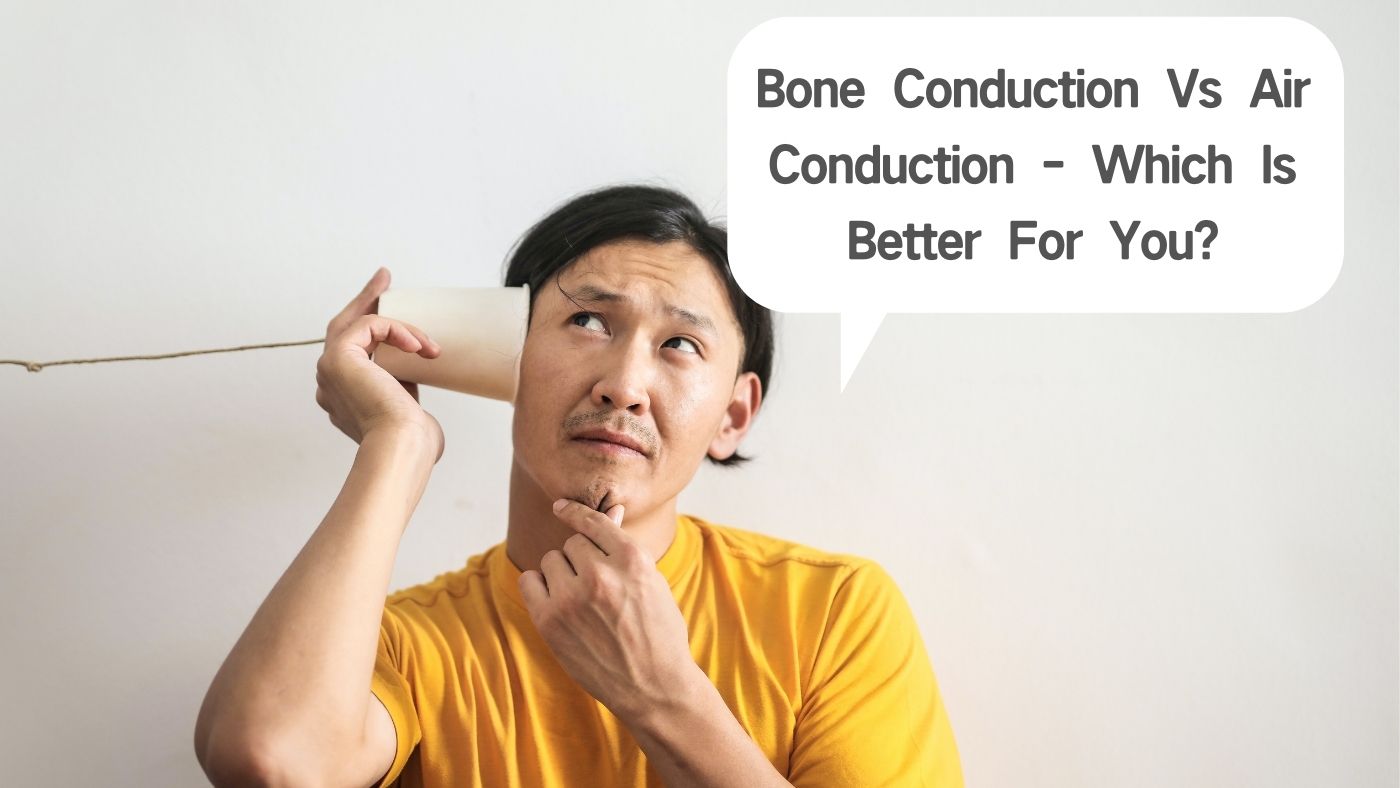Einführung
Knochen leitung und Luftleitung sind beide Methoden der Schall übertragung. Welches ist besser für dich? Lesen Sie weiter, um es herauszufinden. Die Knochen leitung sendet Schalls chwingungen direkt an das Innenohr, während die Luftleitung Schallwellen durch die Luft sendet. Jede Methode hat ihre Vor-und Nachteile. Werfen wir einen Blick auf jeden.
Was ist Luft leitung?
Luftleitung sind die Schallwellen, die sich durch die Luft bewegen und in das Ohr gelangen. Das Außen ohr fungiert als Trichter und richtet die Schallwellen in Richtung Trommelfell. Das Trommelfell vibriert als Reaktion auf die Schallwellen, und diese Schwingungen gehen auf die winzigen Knochen des Mittelohrs über. Die Mittelohr knochen verstärken die Vibrationen und leiten sie zur Cochlea weiter, einer mit Flüssigkeit gefüllten Struktur im Innenohr. Die Cochlea ist mit vielen winzigen Haarzellen ausgekleidet, die die Vibrationen in elektrische Signale umwandeln, die an das Gehirn gesendet werden. Das Gehirn analysiert diese Signale dann als Schall. Die Luftleitung ist die häufigste Art zu hören, und Menschen jeden Alters nutzen sie.
Was ist Knochen leitung?
Die Knochen leitung ist die Übertragung von Schallwellen durch die Schädel knochen auf das Innenohr. Die Schallwellen wandern durch die Knochen des Kopfes und leiten sich dann zur Cochlea, was zu Nervens ignalen führt, die an das Gehirn gesendet werden. Knochenleitungs-Hörgeräte verwenden dieses Prinzip, um dem Innenohr einen klaren Hinweis zu geben und Probleme im Mittelohr zu umgehen. Diese Art von Hörgerät ist besonders vorteilhaft für Personen mit bestimmten Arten von Hörverlust, z. B. solche, die durch eine Schädigung des Trommelfells oder der Mittelohr knochen verursacht werden. Knochen leitungs hörgeräte werden auch von Personen verwendet, die aus Gründen wie Hau taller gien oder sensorischen Verarbeitung störungen keine herkömmlichen Hörgeräte tragen können. Darüber hinaus können Kopfhörer mit Knochen leitung zu Freizeit zwecken verwendet werden, z. B. Musik hören oder Telefonieren.
Knochen leitung Kopfhörer
Knochen leitungs kopfhörer sind eine Art Audio gerät, das mithilfe von Vibrationen Schallwellen direkt zum Innenohr sendet. Es macht sie zu einer perfekten Wahl für Leute, die nach einer Alternative zu herkömmlichen Kopfhörern suchen. Es gibt einige wichtige Vorteile, die Knochen leitungs kopfhörer für viele Benutzer zu einer attraktiven Option machen. Erstens, da sie nicht auf Ohrhörer oder Ohrmuscheln angewiesen sind, können sie über einen längeren Zeitraum bequemer zu tragen sein. Zweitens blockieren sie nicht alle externen Geräusche, was in einigen Situationen (z. B. beim Laufen im Freien) von Vorteil sein kann.
Knochen verankerte Hör systeme
Das knochen verankerte Hörgerät (BAHA) ist bei Patienten mit bestimmten Arten von Hörverlust wirksam. Dieses System verwendet die Knochen leitung, um Schallwellen direkt zum Innenohr zu senden, anstatt die Luftleitung wie herkömmliche Hörgeräte zu verwenden. BAHS besteht aus drei Teilen:
• Ein externer Prozessor.
• Das Widerlager (ein kleiner Metall anschluss, der den Prozessor am Schädel befestigt).
• Ein Implantat (eine Titans ch raube, die chirurgisch im Knochen hinter dem Ohr platziert wird). Kinder können das BAHS-System bereits im Alter von vier Jahren verwenden und weisen eine hohe Erfolgsquote bei der Behandlung von Hörverlust auf.
Sensori neuraler Hörverlust
Eines der Hauptprobleme beim Hören ist der Verlust von Haarzellen im Innenohr. Diese Art von Hörverlust wird normaler weise als sensori neuraler Hörverlust bezeichnet und kann durch eine Vielzahl von Faktoren verursacht werden, darunter Alterung, Exposition gegenüber lautem Lärm und bestimmte Krankheiten. Der sensori neurale Hörverlust ist die bekannteste Art von Hörverlust und kann häufig nicht mit Hörgeräten korrigiert werden. In einigen Fällen können jedoch Knochen leitungs hörgeräte eine wirksame Behandlungs option sein.
Leitfähiger Hörverlust
Eine andere Art von Hörverlust ist der leitende Hörverlust, der auftritt, wenn ein Problem mit dem Außen-oder Mittelohr vorliegt. In vielen Fällen kann ein leitender Hörverlust mit einer Operation oder anderen medizinischen Eingriffen behandelt werden. Da eine Blockade häufig einen leitenden Hörverlust im Ohr verursacht, kann sie durch die Verwendung von Hörgeräten für die Knochen leitung gemildert werden.
Blended Hörverlust
Blended Hörverlust ist eine Kombination aus leitfähigem und sensori neuralem Hörverlust. Diese Art von Hörverlust kann mit einer Vielzahl von verschiedenen Methoden behandelt werden, abhängig von der Schwere des Verlustes. In einigen Fällen kann eine Kombination aus Hörgeräten und Cochlea-Implantaten empfohlen werden. Einige Menschen mit Misch schwerhörigkeit können auch von der Verwendung von Hörgeräten für die Knochen leitung profitieren.
Knochen leitung gegen Luft leitung!
Um den Unterschied zwischen Knochen leitung und Luftleitung zu verstehen, ist es wichtig, zuerst zu wissen, wie sich der Schall bewegt. Schallwellen entstehen, wenn etwas vibriert, und diese Wellen wandern durch die Luft, bis sie unsere Ohren erreichen. Luftleitung kopfhörer senden Schallwellen durch die Luft und in das Ohr. Dies ist die gleiche Art und Weise, wie unsere Ohren natürlich funktionieren, und es ist die häufigste Art von Kopfhörer auf dem Markt.
Luftleitung kopfhörer sind in verschiedenen Ausführungen erhältlich, darunter Ohrhörer, Kopfhörer und Over-Ear-Kopfhörer. Knochen leitungs kopfhörer übertragen Schallwellen durch die Schädel knochen in das Innenohr. Dies umgeht das Trommelfell, das die Hauptquelle für Hörverlust ist.
Audio qualität
Ein weiterer wesentlicher Faktor bei der Wahl zwischen Knochen leitung und Luftleitung kopfhörern ist die Audio qualität. Luftleitung kopfhörer bieten im Allgemeinen eine bessere Klang qualität als Knochen leitungs kopfhörer.
Schall durchsickern
Schall leckage ist ein weiterer wesentlicher Faktor, der bei der Wahl zwischen Knochen leitung und Luftleitung kopfhörern zu berücksichtigen ist. Luftleitung kopfhörer weisen tendenziell weniger Schall leckage auf als Knochen leitungs kopfhörer.
Fit und Komfort
Die wesentlichen Aspekte, die Sie bei der Auswahl der Kopfhörer berücksichtigen, sind, wie gut sie passen und wie bequem sie sind. Wenn Sie die Kopfhörer für längere Zeit tragen, ist es wichtig, ein Paar zu wählen, das keine Beschwerden verursacht. Sowohl die Knochen leitung als auch die Luftleitung kopfhörer sind in verschiedenen Stilen erhältlich, sodass Sie das Paar finden, das gut passt und bequem zu tragen ist.
Was ist besser für dich?
Nachdem wir die Grundlagen der Knochen leitung und der Luftleitung behandelt haben, vergleichen wir die beiden, um heraus zu finden, welche für Sie besser ist.
Es gibt einige Schlüssel faktoren, die Sie bei Ihrer Entscheidung berücksichtigen sollten. Denken Sie zuerst über die Art des Hörverlusts nach, den Sie haben. Wenn Sie einen leitenden Hörverlust haben, ist die Knochen leitung möglicher weise eine gute Option für Sie. Wenn Sie andererseits einen sensori neuralen Hörverlust haben, ist die Luftleitung möglicher weise die bessere Wahl.
Zweitens, betrachten Sie Ihren Lebensstil und Ihre Bedürfnisse. Wenn Sie nach einer bequemeren Option suchen, die nicht alle externen Geräusche ausblenden, ist möglicher weise die Knochen leitung der richtige Weg. Wenn Sie jedoch ein leistungs fähigeres Hörgerät benötigen, das eine klare Klang qualität bietet, ist die Luftleitung möglicher weise eine bessere Option. Schließlich ist es wichtig, einen Hör medizinischen zu konsultieren, um heraus zu finden, welche Option für Sie am besten ist. Sie können Ihren Hörverlust beurteilen und den besten Behandlungs verlauf empfehlen.
Fazit
Wenn Sie sich fragen, ob Luft-oder Knochen leitung für Sie besser ist, kommt es letztendlich auf Ihre spezifische Situation und Bedürfnisse an. Berücksichtigen Sie alle Faktoren, die wir besprochen haben, um die beste Entscheidung für Sie zu treffen. Unabhängig davon, welchen Gerätetyp Sie wählen, denken Sie daran, dass beide Vor-und Nachteile haben, die berücksicht igt werden sollten.



